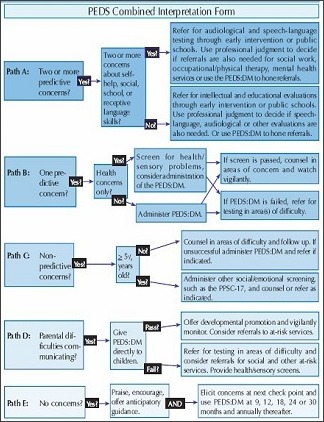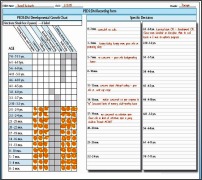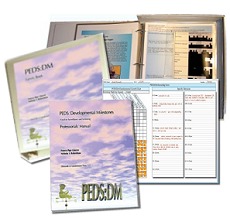Help for PEDS® Users
PEDS® users will appreciate the supporting information the PEDS:DM® provides:

- When Path B calls for additional developmental screening, the PEDS:DM® can quickly (via 6 – 8 items) determine whether a referral is needed or rather if developmental promotion and careful monitoring are the best responses.
- Similarly, Path C often needs supporting information, especially in children 4 years and older in the presence of persistent concerns about behavior or social-emotional development. The PEDS:DM® supplies this quickly and for older children, Section 2 of the PEDS:DM® Family book also houses the Pictorial Pediatric Symptoms Checklist-17 which has factor scores for depression/anxiety, conduct problems, and attention problems, and the Vanderbilt ADHD Diagnostic Rating Scale.
- For parents on Path D (or anytime clinicians suspect a problem but parents do not), the PEDS:DM® can be administered directly to children or by professional observation (when children are less than two years of age). Section 2 of the Family Book also houses the Family Psychosocial Screen and the Brigance Parent-Child Interaction Scale (helpful measures to also use with Path D families)
You can use PEDS® and the PEDS:DM® in two ways:
- Administer both at each visit (a total of 16 – 18 items). This takes about 7 minutes total.
- Administer PEDS® routinely and the PEDS:DM® as indicated (on the PEDS® Combined Recording Form)
How the two measures work together

The PEDS® Combined Recording Form has the PEDS® Score Form (just like the one you’ve been using except that it is printed in blue). The Recording Form also has a PEDS® Interpretation Form but this version is modified to show you where the PEDS:DM® is indicated and what to do with the results of both measures (e.g., refer if a child on PEDS® Path B fails the PEDS:DM®)
What you’ll need:
The PEDS:DM® (Pediatric and Public Health Starter complete set). The complete set includes the PEDS:DM® Family Book (where the laminated PEDS:DM® forms and illustrations need for administration are housed), the  Professionals’ Manual (which includes administration directions, guides to using supplemental measures, parent information guides, etc.), the PEDS:DM® Binder case for scoring, and 100 PEDS® Combined Recording Forms. You’ll need extra copies of the Family Book if your clinic has lots of same age children arriving simultaneously, and ideally, a manual for each exam room.
Professionals’ Manual (which includes administration directions, guides to using supplemental measures, parent information guides, etc.), the PEDS:DM® Binder case for scoring, and 100 PEDS® Combined Recording Forms. You’ll need extra copies of the Family Book if your clinic has lots of same age children arriving simultaneously, and ideally, a manual for each exam room.
- PEDS® Response Forms
- The PEDS® Brief Guide
- PEDS® Combined Recording Forms (100 of these come with the PEDS:DM® pediatric/public health version).
Making it work
It is easiest to just use both measures at once. If so:
- Select the right set of items in the PEDS:DM® for the child’s age (using the guide in the inside cover of the PEDS:DM®. Ages are not shown on the forms themselves so as to minimize potential distress for families with delayed children).
- Place the PEDS® Response Form on top of the correct PEDS:DM® page
- Ask parents to complete both pages.
Note: the PEDS:DM® is laminated and comes with fine point dry erase markers. Have parents use the marker to fill out PEDS® as well (in order to avoid marring the PEDS:DM® materials). Do not laminate the PEDS® Response Form though. You need to keep that in the child’s chart as proof of screening and to follow up with prior concerns at the next visit. Then when a new PEDS® Response Form is completed, you can replace the old one if your chart is getting to full!
- When they’ve finished both, first score the PEDS:DM®, (a scoring template is placed over the completed form and immediately reveals whether there are correct answers).
- Color in the boxes on the PEDS:DM® Growth Chart (on the back side of the PEDS® Combined Recording Form for each passed item. Place a – in the box for each missed in item. For skipped items (in between visits), you can color those in up to the highest pass.
- Score PEDS® as you normally would and follow directions on the PEDS® Score Form portion of the PEDS® Combined Recording Form to find the correct path on the PEDS® Combined Interpretation Form. Read through the entire path to identify what to do next (e.g., refer, advise, temporize, or monitor).
Help For PEDS® Users In NICU Follow-Up Or Child-Find Programs
The PEDS:DM® Assessment Level Version is designed for more detailed evaluation of children’s progress and is especially helpful with children for whom there is an elevated risk of delay and thus greater likelihood of uneven development. You can still use the primary care version of the measure as a starting point, (if so, please read the above carefully). But, you will probably prefer the assessment level.
What the PEDS:DM® Assessment Level offers:
- The ability to view strengths and weaknesses across all developmental domains (fine motor, receptive language, expressive language, gross motor, self-help, social-emotional, and for older children reading and math skills).
- Age equivalent scores (as well as cutoffs) so that you can produce percentage of delay scores (or percentage of skills mastered at chronological age)
- Reusable booklets, one per child, for monitoring over time.
Why use both PEDS® and the PEDS:DM® Assessment Level?
- PEDS® gives you insight into parents issues and needs
- PEDS® helps parents think about development as a range of domains
- PEDS® enhances the teachable moment
- PEDS® helps parents feel they have a collaborator in child-rearing and someone they can talk to about their concerns. This is known to reduce parenting frustration and promotes positive parenting practices such as time-out, rather than spanking
- PEDS® reduces “oh by the way” concerns and helps focus the visit
- The PEDS:DM® helps confirm or disconfirm parents’ concerns, enabling providers to effectively and efficiently respond to both parents’ issues and children’s needs.
What you’ll need:
- PEDS® Brief Guide
- PEDS® Response Form
- PEDS® Score/Interpretation Form
- PEDS:DM® for NICU/Early Intervention (The complete set includes the PEDS:DM® Family Book (where the laminated PEDS:DM® forms and illustrations need for administration are housed), the Professionals’ Manual (which includes administration directions, guides to using supplemental measures, parent information guides, etc.), the PEDS:DM® Binder case for scoring, and 25 PEDS® Assessment Level Booklets. You’ll need one booklet per child but multiple administrations over time can be conducted with the same booklet.
Making it work
By Telephone (for Intake and Triage)
- Administer PEDS® first. This helps start a dialogue and sets a focus for the call.
- If Path B, C, or D, identify the correct PEDS:DM® items for the child’s age and administer these by interview.
- Score the PEDS:DM® and PEDS® and follow the Path identified by PEDS® to decide whether the PEDS:DM® Assessment Level version is needed, i.e., if items are failed on the PEDS:DM® at age level.
- If so, on an Assessment Level Booklet, identify the domain(s) requiring further exploration, mark those items already administered, locate and mark answers for the items. Administer by interview, items below those already failed until reaching three passed items in a row if possible (using the Scoring Guide in Chapter 8). Also probe above the failed items to attain three failed items in a row.
- Use the last page of the Assessment booklet to determine age-equivalent scores and percentage of delay.
- An alternative is to mail the Assessment Level Booklet to families to complete on their own. If so, you will need make a color copy of the stimuli (from Section 3 of the Family book) and insert these pages into the Booklet. You can also download and print a copy of these images at www.pedstest.com.
- If using the Assessment Booklet as a mail-out, write the word “START” next to the item that is 3 – 4 below the item for chronological age for each domain (see Chapter 8 for the relationship between items and age).
- Be sure to include a self-addressed stamped envelop with the Booklet to facilitate its return.
In Person
- You can administer the Assessment Level PEDS:DM® directly to children either in part or entirely (guidance for this approach is given in Chapter 6), or let families complete items on their own. If the latter:
- Mark the PEDS:DM® Assessment level booklet with starting points (at least 3 items below chronological age, or if younger than 5 months, at the first item). You can write “START” to indicate where parents should begin. Stopping points are described for parents on the cover (but if you think parents might be confused, write “STOP” about 3 – 4 items above chronological age (there’s a guide in Chapter 8 of the PEDS:DM® Professionals’ Manual for the chronological age associate with each item).
- Attach the PEDS® Response Form to the front of the PEDS:DM® Assessment Level Booklet.
- Give the parents the Family Book opened to Section 3 (where all the stimuli needed for self-administration are included), and the PEDS® Response Form with the PEDS:DM® Assessment booklet.
- Score PEDS® and the PEDS:DM® Assessment Level (per guidelines in Chapter 8) and prepare the Recording Grid for sharing with families (computing age equivalent scores, percentage of delay, or percentage of skills mastered, and using a highlighter to create the bar graph (color in spaces up to the highest pass and drawing a line to represent chronological age).
- Chapter 6 contains guidance on explaining test results to families, and making use of their concerns on PEDS® as a starting point for the discussion.
